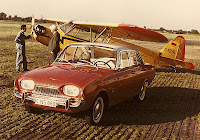In 1960 Ford-Werke GmbH (Ford of Germany) introduced the new Ford Taunus 17 M. It was the third newly designed German Ford to be launched after the war and for this reason it was from inception known within the company as Ford Project 3 (P3) or the Ford Taunus P3. The new car was nicknamed by the press as the “Badewanne” (Bath tub). Unlike the first post-war models with a North American design, the Taunus P3 was designed by German born Uwe Bahnsen.

Ford Taunus 17M 2-doors
The Taunus 17 M was available as a two-door, four-door saloon and a three-door “Turnier” station wagon. Coach built two-door cabriolets and coupé’s were offered by Karl Deutsch in Cologne, only about 150 were produced. There were three different engine sizes offered, being the 1498 cc, the 1698 cc and, from 1961, a new larger 1757 cc engine. Power outputs initially ranged from 55 PS (40 kW; 54 hp) to 60 PS (44 kW; 59 hp). All engines were petrol powered L4 water-cooled units.
Ford Taunus 17M Turnier
669,731 cars were produced during a four year production run (1960-1964).
Ford Taunus 17M Cabrio by Karl Deutsch (Cologne)
French Ad
German Ad 1
German Ad 2
German Ad 3
German Ad 4
German Ad 5
German Ad 6











































